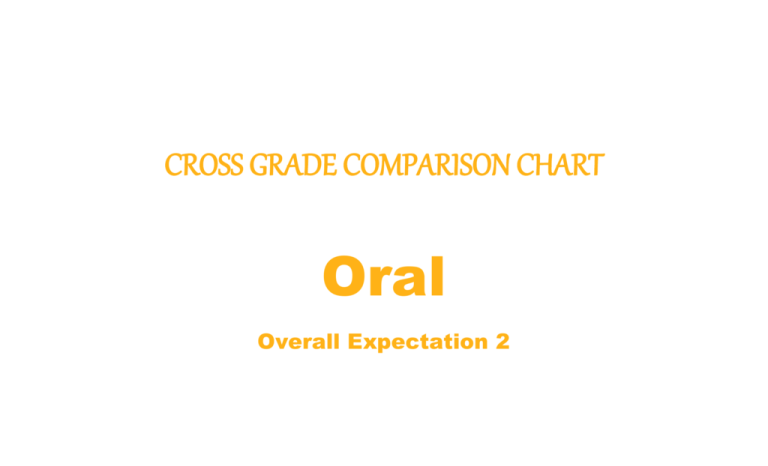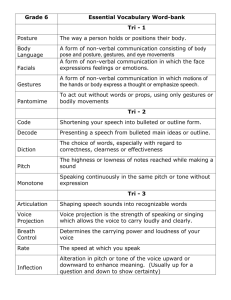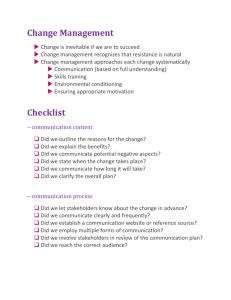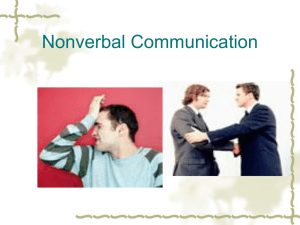Oral 2
advertisement

CROSS GRADE COMPARISON CHART Oral Overall Expectation 2 ORAL COMMUNICATION OVERALL EXPECTATION # 2: use speaking skills and strategies appropriately to communicate with different audiences for a variety of purposes; Speaking to Communicate 2.1 Purpose Grade 1 Grade 2 Grade 3 Grade 4 identify a few purposes for speaking (e.g., to express needs to peers and the teacher; to establish positive personal and learning relationships with peers; to activate prior knowledge and make connections before listening; to retell stories and recount personal experiences to the class; to ask questions or explore solutions to problems in smallgroup and paired activities; to share ideas and information that contribute to understanding in large and small groups; to manipulate the sounds of language in songs, chants, and poems) identify a variety of purposes for speaking (e.g., to entertain the class; to establish positive personal and learning relationships with peers; to ask questions or explore solutions to problems in small-group and paired activities; to give directions to a partner in a shared activity; to explain to a small group the method used to solve a problem; to share ideas or information in large and small groups) identify a variety of purposes for speaking (e.g., to entertain an audience; to establish positive personal and learning relationships with peers; to ask questions or explore solutions to problems in small group and paired activities; to explain to a small group how to play a new game; to present to the class an item or event of personal interest; to share ideas or information in order to contribute to understanding in large or small groups) identify a variety of purposes for speaking (e.g., to entertain a wider school audience; to establish positive personal and learning relationships with peers; to ask questions or explore solutions to problems in small-group and paired activities; to solicit opinions and react to information and ideas in a discussion or dialogue group; to explain to another person how something works; to summarize and comment on an event or oral text for the class; to clarify and organize thinking in order to contribute to understanding in large and small groups) Grade 5 Grade 6 Grade 7 Grade 8 identify a variety of purposes for speaking (e.g., to justify opinions and thinking in discussion and dialogue groups; to ask questions or explore solutions to problems in small groups; to share information or ideas about a topic with a group; to share data; to entertain; to interact in social situations; to contribute meaningfully and work constructively in groups) identify a variety of purposes for speaking and explain how the purpose and intended audience influence the choice of form (e.g., to clarify thinking through dialogue; to explore different points of view through drama and role playing; to present information to a group) identify a range of purposes for speaking and explain how the purpose and intended audience might influence the choice of speaking strategies (e.g., to present conclusions about a research project through dramatization, a role play, or a monologue; to interest classmates in a social issue through a debate; to solve problems or investigate issues and ideas through a group brainstorming session) identify a range of purposes for speaking in a variety of situations, both straightforward and more complex, and explain how the purpose and intended audience might influence the choice of speaking strategies (e.g., to introduce a speaker; to support the resolution in a debate; to dramatize a favourite poem; to explain a complex procedure to an individual or group; to work towards the solution to a problem with a partner) 2.2 Interactive Strategies Grade 1 Grade 2 Grade 3 Grade 4 demonstrate an understanding of appropriate speaking behaviour in a few different situations, including paired sharing and small- and large- group discussions (e.g., give other group members an opportunity to speak; respond positively to the contributions of others; stay on topic and speak to the point) demonstrate an understanding of appropriate speaking behaviour in a variety of situations, including paired sharing and small- and large-group discussions (e.g., make connections to what other group members have said; demonstrate an understanding of when to speak, when to listen, and how much to say) demonstrate an understanding of appropriate speaking behaviour in a variety of situations, including smalland large-group discussions (e.g., paraphrase or restate other group members’ contributions; acknowledge another person’s point of view; link their responses to the topic of conversation and/or what was said by the previous speaker) demonstrate an understanding of appropriate speaking behaviour in a variety of situations, including paired sharing and small- and large-group discussions (e.g., acknowledge and extend other group members’ contributions; make relevant and constructive comments on the contributions of other group members) Oral - Overall Expectation 2 Page 1/4 Grade 5 Grade 6 Grade 7 Grade 8 demonstrate an understanding of appropriate speaking behaviour in a variety of situations, including paired sharing, dialogue, and small- and large- group discussions (e.g., ask questions to clarify understanding before responding; respond to a group member’s comment by making a personal connection to their own experience; show awareness of and sensitivity towards the background and experiences of other group members when expressing their own views) demonstrate an increasingly sophisticated understanding of appropriate speaking behaviour in a variety of situations, including paired sharing, dialogue, and smalland large-group discussions (e.g., acknowledge different points of view; paraphrase to clarify meaning; adjust the level of formality to suit the audience and purpose for speaking) demonstrate an understanding of appropriate speaking behaviour in most situations, adapting contributions and responses to suit the purpose and audience (e.g., ask questions and paraphrase to confirm understanding; request repetition or an explanation from other group members when meaning is unclear; use language and forms of address that are appropriate to the formality or informality of the situation) demonstrate an understanding of appropriate speaking behaviour in most situations, using a variety of speaking strategies and adapting them to suit the purpose and audience (e.g., paraphrase different points of view on an issue to clarify alternative perspectives; affirm the contributions of others before responding; avoid making highly personal remarks in public or in formal situations) Grade 1 Grade 2 Grade 3 Grade 4 communicate ideas and information orally in a clear, coherent manner (e.g., use a logical framework such as a beginning, middle, and end sequence to retell a story read aloud by the teacher) communicate ideas, opinions, and information orally in a clear, coherent manner using simple but appropriate organizational patterns (e.g., give an oral account of a current event using the five W’s to organize the information; restate the main facts from a simple informational text in correct sequence) communicate orally in a clear, coherent manner, presenting ideas, opinions, and information in a logical sequence (e.g., use an organizational pattern such as comparison or chronological order in presenting a short oral report) communicate in a clear, coherent manner, presenting ideas, opinions, and information in a readily understandable form (e.g., respond in an appropriate order to multi-part, higher-level questions in a student-teacher conference or a group discussion; explain the results of research in an oral presentation, including a statement of the research focus, the procedures followed, and the conclusions reached; use an organizational pattern such as chronological order or cause and effect to present ideas in a dialogue or discussion) Grade 5 Grade 6 Grade 7 Grade 8 communicate orally in a clear, coherent manner, presenting ideas, opinions, and information in a readily understandable form (e.g., present an argument that has a clearly stated purpose, point-by-point development, and relevant supporting details) communicate orally in a clear, coherent manner, using appropriate organizing strategies and formats to link and sequence ideas and information (e.g., present an argument in favour of one point of view on an issue, with an opening statement, sequence of points with supporting evidence, and summary/conclusion) communicate orally in a clear, coherent manner, using a structure and style appropriate to both the topic and the intended audience (e.g., use a formal structure of opening statement, enumeration of points, and summary/conclusion, and a straightforward, impersonal style, to present a position statement on an issue) communicate in a clear, coherent manner, using a structure and style appropriate to the purpose, the subject matter, and the intended audience (e.g., combine logic with an appeal to emotion in a charity fund-raising speech; use a cause-andeffect structure in a report on the rise of a political movement or the emergence of a contentious Aboriginal issue) 2.3 Clarity and Coherence Oral - Overall Expectation 2 Page 2/4 2.4 Appropriate Language Grade 1 Grade 2 Grade 3 Grade 4 choose appropriate words to communicate their meaning accurately and engage the interest of their audience (e.g., choose words relevant to the topic from the full range of their vocabulary, including new words used regularly in the classroom; use descriptive adjectives to clarify and add interest to a narrative; use inclusive language that conveys respect for all people) choose a variety of appropriate words and phrases to communicate their meaning accurately and engage the interest of their audience (e.g., use descriptive adjectives and adverbs to create vivid images for their audience) choose a variety of appropriate words and phrases, including descriptive words and some technical vocabulary, and a few elements of style, to communicate their meaning accurately and engage the interest of their audience (e.g., use alliteration for emphasis; use comparatives such as like, instead of, however, the same as, compared to, unlike to clarify similarities and differences; use appropriate technical terms when explaining a scientific investigation) use appropriate words and phrases from the full range of their vocabulary, including inclusive and non-discriminatory terms, and appropriate elements of style, to communicate their meaning accurately and engage the interest of their audience (e.g., use evaluative terms to clarify opinions and for emphasis; use descriptive words to give specificity and detail to personal anecdotes; use humour or emotive language to engage the audience’s interest or sympathy) Grade 5 Grade 6 Grade 7 Grade 8 use appropriate words and phrases from the full range of their vocabulary, including inclusive and nondiscriminatory language, and stylistic devices suited to the purpose, to communicate their meaning accurately and engage the interest of their audience (e.g., use evocative images, personal anecdotes, quotations, vocabulary from curriculum subject areas, and appropriate technical terminology to achieve particular effects) use appropriate words and phrases from the full range of their vocabulary including inclusive and nondiscriminatory language, and stylistic devices appropriate to the purpose and context, to communicate their meaning accurately and engage the interest of their intended audience (e.g., use similes, personification, and comparative adjectives and adverbs to achieve a desired effect) use appropriate words, phrases, and terminology from the full range of their vocabulary, including inclusive and nondiscriminatory language, and a range of stylistic devices, to communicate their meaning accurately and engage the interest of their intended audience (e.g., use the technical vocabulary of the subject area during a scientific investigation in a group setting; incorporate literary language and structures into personal anecdotes or imaginative narratives; use emotive language in a persuasive appeal to a large group) use appropriate words, phrases, and terminology from the full range of their vocabulary, including inclusive and nondiscriminatory language, and a range of stylistic devices, to communicate their meaning effectively and engage the interest of their intended audience (e.g., use imagery, figurative language such as similes and analogies, and other stylistic elements such as idioms and onomatopoeia to evoke a particular mood in a dramatic monologue or an appeal for support) 2.5 Vocal Skills and Strategies Grade 1 Grade 2 Grade 3 Grade 4 begin to identify some vocal effects, including tone, pace, pitch, and volume, and use them appropriately to help communicate their meaning (e.g., increase volume to emphasize important points or to communicate to a large audience) identify some vocal effects, including tone, pace, pitch, and volume, and use them appropriately, and with sensitivity towards cultural differences, to help communicate their meaning (e.g., adjust volume to suit the purpose for speaking and the size and type of audience) identify some vocal effects, including tone, pace, pitch, and volume, and use them appropriately, and with sensitivity towards cultural differences, to help communicate their meaning (e.g., pause in appropriate places long enough to allow others to respond during dialogue with peers or in small groups) identify some vocal effects, including tone, pace, pitch, volume, and a range of sound effects, and use them appropriately and with sensitivity towards cultural differences to help communicate their meaning (e.g., adjust the pace of speaking for effect and to hold the listener’s attention) Grade 5 Grade 6 Grade 7 Grade 8 identify some vocal effects, including tone, pace, pitch, volume, and a variety of sound effects, and use them appropriately and with sensitivity towards cultural differences to help communicate their meaning (e.g., use a formal or informal tone as required by the context) identify a range of vocal effects, including tone, pace, pitch, volume, and a variety of sound effects, and use them appropriately and with sensitivity towards cultural differences to help communicate their meaning (e.g., create different-sounding “voices” for the characters in a dramatization of a story) identify a range of vocal effects, including tone, pace, pitch, volume, and a variety of sound effects, and use them appropriately and with sensitivity towards cultural differences to communicate their meaning (e.g., use pauses and changes of pace to highlight the introduction of each new point in a speech to the student body) identify a range of vocal effects, including tone, pace, pitch, volume, and a variety of sound effects, and use them appropriately and with sensitivity towards cultural differences to communicate their meaning (e.g., use changes in pitch to differentiate voices in a storytelling session; use tone and volume to clarify implied messages in a rap poem) Grade 2 Grade 3 Grade 4 2.6 Non-verbal Cues Grade 1 Oral - Overall Expectation 2 Page 3/4 identify some non-verbal cues, including facial expression, gestures, and eye contact, and use them in oral communications, appropriately and with sensitivity towards cultural differences, to help convey their meaning identify some non-verbal cues, including facial expression, gestures, and eye contact, and use them in oral communications, appropriately and with sensitivity towards cultural differences, to help convey their meaning identify some non-verbal cues, including facial expression, gestures, and eye contact, and use them in oral communications, appropriately and with sensitivity towards cultural differences, to help convey their meaning identify some non-verbal cues, including facial expression, gestures, and eye contact, and use them in oral communications, appropriately and with sensitivity towards cultural differences, to help convey their meaning (e.g., use body language, such as moving closer, leaning forward, nodding or shaking their head for emphasis, to connect with their audience) Grade 5 Grade 6 Grade 7 Grade 8 identify a variety of non-verbal cues, including facial expression, gestures, and eye contact, and use them in oral communications, appropriately and with sensitivity towards cultural differences, to help convey their meaning (e.g., use facial expression appropriately to indicate agreement or confusion during a discussion) identify a variety of non-verbal cues, including facial expression, gestures, and eye contact, and use them in oral communications, appropriately and with sensitivity towards cultural differences, to help convey their meaning (e.g., count off on their fingers as they present each point in an argument) identify a variety of non-verbal cues, including facial expression, gestures, and eye contact, and use them in oral communications, appropriately and with sensitivity towards cultural differences, to help convey their meaning (e.g., lean into a group to make a point; make eye contact with the person to whom the response/question is directed) identify a variety of non-verbal cues, including facial expression, gestures, and eye contact, and use them in oral communications, appropriately and with sensitivity towards cultural differences, to help convey their meaning (e.g., rehearse and use hand gestures and increased volume to emphasize points during a formal presentation) Grade 1 Grade 2 Grade 3 Grade 4 use one or more appropriate visual aids (e.g., pictures, photographs, props, puppets, masks) to support or enhance oral presentations (e.g., use a set of plastic animals during an oral recount about a visit to a zoo) use a few different visual aids, (e.g., photographs, artefacts, a story map) to support or enhance oral presentations (e.g., use a family photograph as part of an oral recount of an event; use a story map to retell a story) use a variety of appropriate visual aids (e.g., overheads, diagrams, graphic organizers, charts, artefacts) to support or enhance oral presentations (e.g., use a largesize labelled diagram to illustrate an explanation of how soil erodes) use a variety of appropriate visual aids (e.g., CDs or DVDs, computer-generated graphic organizers, concrete materials, artefacts) to support or enhance oral presentations (e.g., use pictures or samples of different kites to illustrate a talk on how to build a kite) Grade 5 Grade 6 Grade 7 Grade 8 use a variety of appropriate visual aids (e.g., posters, charts, maps, globes, computer-generated organizers) to support or enhance oral presentations (e.g., use ministrylicensed software to create a Venn diagram to compare two different biographies) use a variety of appropriate visual aids, (e.g., video images, maps, posters, charts, costumes) to support or enhance oral presentations (e.g., wear a costume to help portray the speaker in a monologue; create a slide show to accompany a report) use a variety of appropriate visual aids (e.g., charts, videos, props, multimedia) to support and enhance oral presentations (e.g., use a short video clip to support a formal presentation) use a variety of appropriate visual aids (e.g., photographs, multimedia, diagrams, graphs, charts, costumes, props, artefacts) to support and enhance oral presentations (e.g., use a chart to clarify the order of events in a report about a scientific breakthrough; use a video clip from an animated cartoon to show how sound is used to complement the image) 2.7 Visual Aids Oral - Overall Expectation 2 Page 4/4







